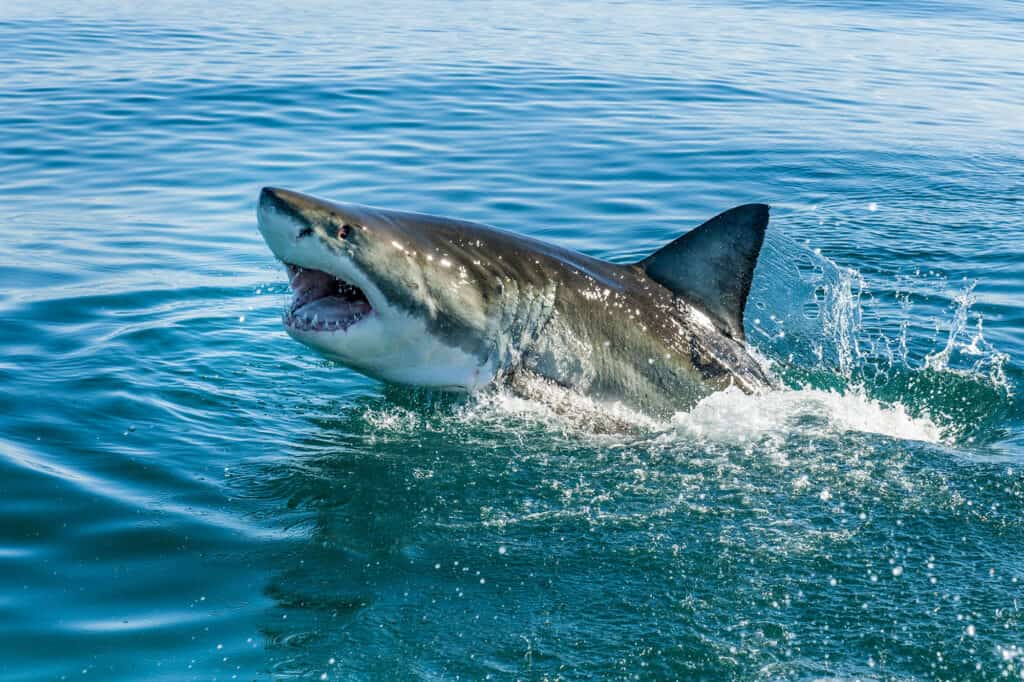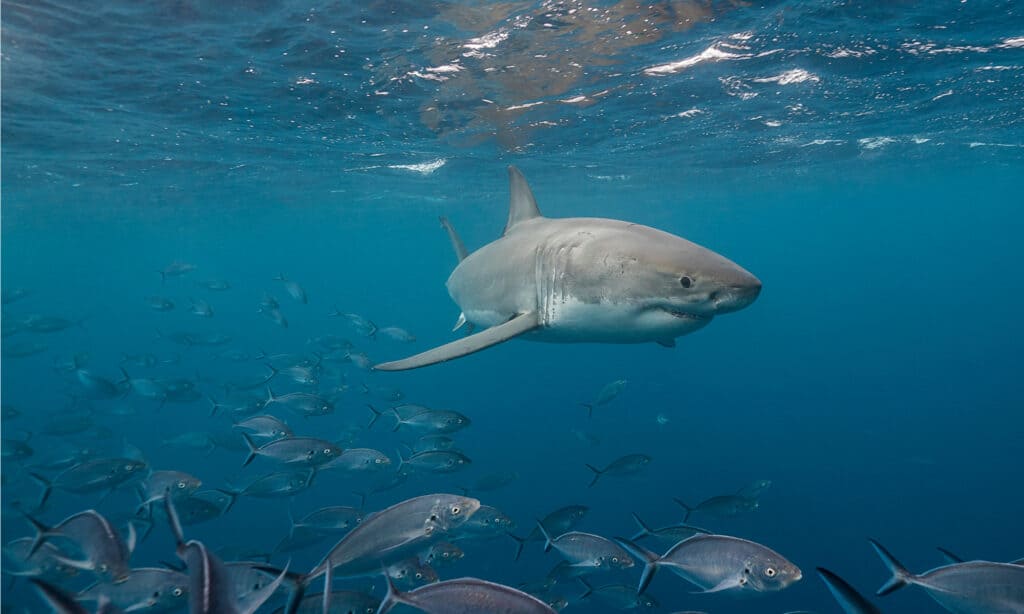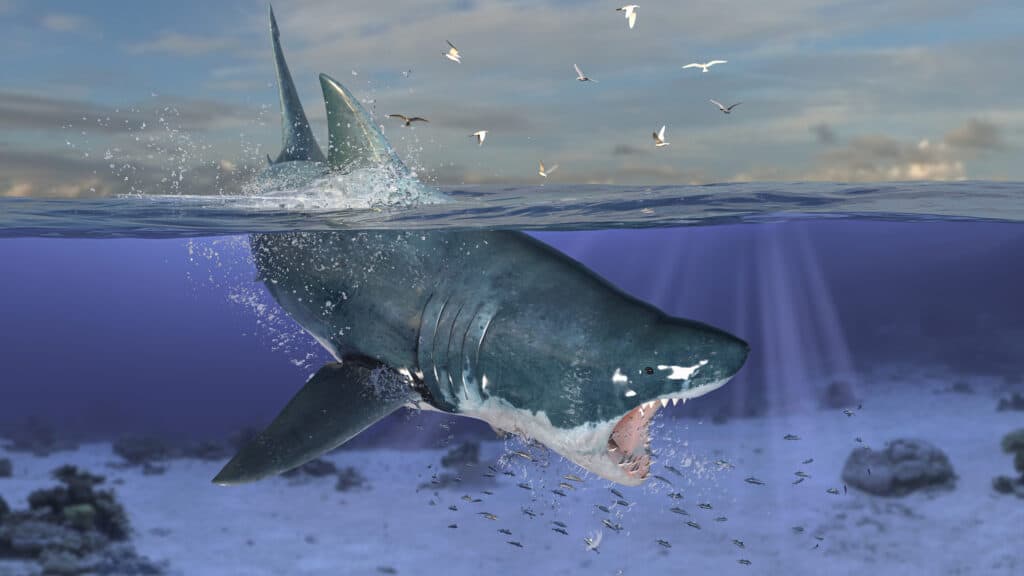Great white sharks have a bad reputation. They are large and aggressive sharks that can grow up to 20 feet long. Despite their size, reputation, and popularity in media, we actually don’t know a lot. Great white sharks have secrets and mysteries they keep hidden well, including where they give birth and live.
Are you interested in learning about the secret habits of these sharks? Keep reading to discover why no one has ever seen a great white shark give birth.
The History of Great White Sharks

iStock.com/ELizabethHoffmann
The great white shark has a long history, dating back at least 400 million years ago. Great white sharks are also closely related to mako sharks. For decades, scientists believed that great white sharks were direct descendants of megatooth sharks, but this was found not to be true. While the exact origin of these massive sharks is unknown, scientists have discovered an ancient great white fossil nursery near Chile. Great white sharks are so old that they may have seen the extinction of the megalodon about 2.6 to 5.3 million years ago.
What Do Great White Sharks Eat?
Like most sharks, great whites are not picky eaters. However, because they are so large, these sharks require large meals. Great white sharks use their strength and seven senses to track, hunt, and kill aquatic mammals like dolphins and seals. Some great white sharks also eat juvenile sharks. They are carnivores and only eat meat. Not all great white sharks hunt every day. Actually, they wait for their stomachs to digest their last meal before striking again. During one meal, these sharks consume between 0.5 and 3.0 percent of their body weight.
How Do Great White Sharks Give Birth?

wildestanimal/Shutterstock.com
There is limited information about what we know about great white sharks. These sharks are viviparous and give birth to live sharks. First, the female white shark grows a baby in an egg inside its womb. When shark pups hatch in the womb, it is a test of survival to the fittest, as they consume unfertilized or fertilized eggs until one remains to be conceived.
While we know the science of how great whites give birth, there are no examples to pull from. Great white sharks are secretive and travel deep into the Pacific Ocean. Although we don’t know exactly what happens during these time frames and travels, it is believed that great white sharks mate and give birth during their trip. The birth is live, and the average young great white is born at 5 feet long.
Why Are Great White Sharks So Secretive?
Great white sharks are natural hunters. They are great at capturing their prey and fleeing from their predators. As surprising as it may sound, orcas (nicknamed killer whales) threaten great white sharks, causing them to flee. Whenever great white sharks feel threatened, they flee into deeper waters. It is hard for scientists to track the movement of great white sharks because they travel thousands of miles quickly and live worldwide.
Some scientists have gotten lucky and tagged juvenile great white sharks to track their movements in hopes of discovering more about their nursery and birthing habits. Not a lot has come from this information. Some great white sharks also work in teams. Researchers noticed this as two great whites hung in the same area for over an hour before attacking larger prey.
While we may never know exactly why great white sharks choose to hide, we know how they do it. As amazing apex predators, they use their unique white and gray coloration to blend into the murky water. Not only is it hard to see them from the ocean’s surface, but they quickly and swiftly retreat to deep waters where tracking is almost impossible. They also change their movements and paths frequently, so tracking them is not easy. Maybe the truth is that great white sharks are not secretive, but we just aren’t good at tracking them.
Can We Study Great White Sharks in Captivity?

iStock.com/https://ift.tt/A6jvgEq
Sadly, great white sharks are not meant for captivity, which makes it even more difficult for us to study their habits, diet, and lives. Great white sharks are long creatures and need space to grow and travel. Rarely do they hunt in the same space. In one year, a great white shark can swim as much as 2,500 miles. Surprisingly, aquariums have tried to keep great whites alive in captivity for research, but more times than not, they bang their heads on the glass and harm or kill themselves.
Before 2004, the longest great white shark to live in captivity was 198 days. Before that, there were cases of great white sharks dying within a week of capture. Sometimes sharks get hurt while they are being captured, as it is not an easy feat. These massive sharks are heavy, weighing anywhere between 4,200 to 5,500 pounds.
Great white sharks feel stress when they are in confined spaces. The only time an aquarium could keep them alive for longer than a month was at Monterey Bay Aquarium. They built a large tank that was 35 feet deep and made for open water animals. However, the great white shark they captured was young and only 4 feet long, compared to the 15 feet they reach in adulthood. After 6 months, the great white shark killed other animals in the tank, and the aquarium set it free. The mystery about great whites continues!
Up Next:
- See a Great White Shark Attack a Drone!
- Great White Shark Lifespan: How Long Do Great White Sharks Live?
- How Do Great White Sharks Mate?
The post Discover Why No One Has Ever Seen a Great White Shark Give Birth appeared first on AZ Animals.
from Animal News, Facts, Rankings, and More! - AZ Animals https://ift.tt/oUBRW2k